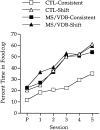Disruption of decrements in conditioned stimulus processing by selective removal of hippocampal cholinergic input
- PMID: 9185560
- PMCID: PMC6573295
- DOI: 10.1523/JNEUROSCI.17-13-05230.1997
Disruption of decrements in conditioned stimulus processing by selective removal of hippocampal cholinergic input
Abstract
The attention directed to environmental stimuli can be modified by experience. For example, preexposure of a conditioned stimulus (CS) in the absence of reinforcement can retard subsequent conditioning of that stimulus when it is paired directly with an unconditioned stimulus, a phenomenon referred to as latent inhibition. Similarly, consistent pairings of a CS with another event can slow the acquisition of new information about that CS. Such phenomena suggest that reductions in the processing of CSs occur when they are made behaviorally irrelevant or consistent predictors of other events. On the basis of the observation that hippocampal lesions prevented such reductions in CS processing, we hypothesized that damage to basal forebrain cholinergic neurons that project to the hippocampus, using microinjections of the selective immunotoxin 192 IgG-saporin into the medial septum/vertical limb of the diagonal band (MS/VDB), also would disrupt normal reductions in CS processing. Lesions of hippocampal cholinergic input disrupted decreases in CS processing, manifested in both an absence of latent inhibition and a lack of reduced processing of a CS that had been a consistent predictor of another CS. These results indicate that cholinergic neurons in the MS/VDB play a role in the regulation of CS processing. Furthermore, these findings (in conjunction with previous findings) implicate both rostral (hippocampal-projecting) and caudal (cortical-projecting) regions of the basal forebrain cholinergic system in the modulation of attention.
Figures



Similar articles
-
Basal forebrain cholinergic lesions disrupt increments but not decrements in conditioned stimulus processing.J Neurosci. 1995 Nov;15(11):7315-22. doi: 10.1523/JNEUROSCI.15-11-07315.1995. J Neurosci. 1995. PMID: 7472485 Free PMC article.
-
Removal of cholinergic input to rat posterior parietal cortex disrupts incremental processing of conditioned stimuli.J Neurosci. 1998 Oct 1;18(19):8038-46. doi: 10.1523/JNEUROSCI.18-19-08038.1998. J Neurosci. 1998. PMID: 9742170 Free PMC article.
-
Impairments in conditioned stimulus processing and conditioned responding after combined selective removal of hippocampal and neocortical cholinergic input.Behav Neurosci. 1999 Jun;113(3):486-95. doi: 10.1037//0735-7044.113.3.486. Behav Neurosci. 1999. PMID: 10443776
-
Immunolesion of the cholinergic basal forebrain: effects on functional properties of hippocampal and septal neurons.Int J Dev Neurosci. 1998 Nov-Dec;16(7-8):613-32. doi: 10.1016/s0736-5748(98)00073-2. Int J Dev Neurosci. 1998. PMID: 10198811 Review.
-
Immunolesion by 192IgG-saporin of rat basal forebrain cholinergic system: a useful tool to produce cortical cholinergic dysfunction.Prog Brain Res. 1996;109:253-64. doi: 10.1016/s0079-6123(08)62109-3. Prog Brain Res. 1996. PMID: 9009714 Review.
Cited by
-
Neurons in the Primate Medial Basal Forebrain Signal Combined Information about Reward Uncertainty, Value, and Punishment Anticipation.J Neurosci. 2015 May 13;35(19):7443-59. doi: 10.1523/JNEUROSCI.0051-15.2015. J Neurosci. 2015. PMID: 25972172 Free PMC article.
-
Nonpharmacological amelioration of age-related learning deficits: the impact of hippocampal theta-triggered training.Proc Natl Acad Sci U S A. 2005 Sep 13;102(37):13284-8. doi: 10.1073/pnas.0506515102. Epub 2005 Sep 6. Proc Natl Acad Sci U S A. 2005. PMID: 16150707 Free PMC article.
-
Redundant basal forebrain modulation in taste aversion memory formation.J Neurosci. 1999 Sep 1;19(17):7661-9. doi: 10.1523/JNEUROSCI.19-17-07661.1999. J Neurosci. 1999. PMID: 10460272 Free PMC article.
-
A computational account of threat-related attentional bias.PLoS Comput Biol. 2019 Oct 10;15(10):e1007341. doi: 10.1371/journal.pcbi.1007341. eCollection 2019 Oct. PLoS Comput Biol. 2019. PMID: 31600187 Free PMC article.
-
Stimulus preexposure speeds or slows subsequent acquisition of associative learning depending on learning test procedures and response measure.Learn Behav. 2018 Jun;46(2):134-156. doi: 10.3758/s13420-017-0297-7. Learn Behav. 2018. PMID: 29052113 Free PMC article.
References
-
- Ackil JE, Mellgren RL, Halgren C, Frommer GP. Effects of CS preexposures on avoidance learning in rats with hippocampal lesions. J Comp Physiol Psychol. 1969;69:739–747. - PubMed
-
- Amaral DG, Kurz J. An analysis of the origins of the cholinergic and noncholinergic septal projections to the hippocampal formation of the rat. J Comp Neurol. 1985;240:37–59. - PubMed
-
- Bassant MH, Apartis E, Jazat-Poindessous FR, Wiley RG, Lamour YA. Selective immunolesion of the basal forebrain cholinergic neurons: effects on hippocampal activity during sleep and wakefulness in the rat. Neurodegeneration. 1995;4:61–70. - PubMed
-
- Baxter MG, Gallagher M. Intact spatial learning in both young and aged rats following selective removal of hippocampal cholinergic input. Behav Neurosci. 1996;110:460–467. - PubMed
-
- Baxter MG, Gallagher M. Cognitive effects of selective loss of basal forebrain cholinergic neurons: implications for cholinergic therapies of Alzheimer’s disease. In: Brioni JD, Decker MW, editors. Pharmacological treatment of Alzheimer’s disease: molecular and neurobiological foundations. Wiley; New York: 1997. pp. 87–103.
Publication types
MeSH terms
Substances
Grants and funding
LinkOut - more resources
Full Text Sources
Other Literature Sources
